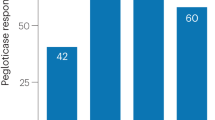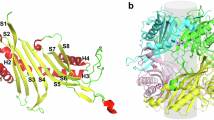Abstract
TREATMENT of hyperuricaemia and gout is aimed at either synthesis or elimination of uric acid. Previous attempts at in situ destruction of uric acid have remained experimental because of imperfections in the enzymes. The therapeutic use of a new uricase or urate oxidase derived from Aspergillus flavus has been studied.
This is a preview of subscription content, access via your institution
Access options
Subscribe to this journal
Receive 51 print issues and online access
$199.00 per year
only $3.90 per issue
Buy this article
- Purchase on SpringerLink
- Instant access to full article PDF
Prices may be subject to local taxes which are calculated during checkout
Similar content being viewed by others
References
Altman, K. I., Smull, K., and Barron, E. S. G., Arch. Biochem., 21, 158 (1949).
London, M., and Hudson, P. B., Science, 125, 937 (1957).
Laboureur, P., and Langlois, C., C.R. Acad. Sci., 264, 2244 (1967).
Liddle, L., Seegmuller, J. E., and Laster, L., Lab. Clin. Med., 54, 903 (1959).
Gros, P., and Raveux, P., Bull. Soc. Chim. France (in the press).
Author information
Authors and Affiliations
Rights and permissions
About this article
Cite this article
KISSEL, P., LAMARCHE, M. & ROYER, R. Modification of Uricaemia and the Excretion of Uric Acid Nitrogen by an Enzyme of Fungal Origin. Nature 217, 72–74 (1968). https://doi.org/10.1038/217072a0
Received:
Revised:
Issue date:
DOI: https://doi.org/10.1038/217072a0
This article is cited by
-
Immunological aspects of urate oxidase therapy in hyperuricaemia
Irish Journal of Medical Science (1977)



